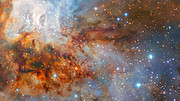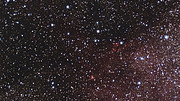Digitized Sky Survey image around the stellar cluster RCW 38
Videos
Zooming into RCW 38
Panning across RCW 38
New observations with ESO’s Very Large
Telescope show the star cluster RCW 38 in all its glory. This image was
taken during testing of the HAWK-I camera with the GRAAL adaptive optics
system. It shows RCW 38 and its surrounding clouds of brightly glowing
gas in exquisite detail, with dark tendrils of dust threading through
the bright core of this young gathering of stars.
This image shows the star cluster RCW 38, as captured by the HAWK-I infrared imager mounted on ESO’s Very Large Telescope
(VLT) in Chile. By gazing into infrared wavelengths, HAWK-I can examine
dust-shrouded star clusters like RCW 38, providing an unparalleled view
of the stars forming within. This cluster contains hundreds of young,
hot, massive stars, and lies some 5500 light-years away in the
constellation of Vela (The Sails).
The central area of RCW 38 is visible here as a bright, blue-tinted region, an area inhabited by numerous very young stars and protostars
that are still in the process of forming. The intense radiation pouring
out from these newly born stars causes the surrounding gas to glow
brightly. This is in stark contrast to the streams of cooler cosmic dust
winding through the region, which glow gently in dark shades of red and
orange. The contrast creates this spectacular scene — a piece of
celestial artwork.
Previous images of this region
taken in optical wavelengths are strikingly different — optical images
appear emptier of stars due to dust and gas blocking our view of the
cluster. Observations in the infrared, however, allow us to peer through
the dust that obscures the view in the optical and delve into the heart
of this star cluster.
HAWK-I is installed on Unit Telescope 4 (Yepun)
of the VLT, and operates at near-infrared wavelengths. It has many
scientific roles, including obtaining images of nearby galaxies or large
nebulae as well as individual stars and exoplanets. GRAAL is an adaptive optics module which helps HAWK-I to produce these spectacular images.
It makes use of four laser beams projected into the night sky, which
act as artificial reference stars, used to correct for the effects of
atmospheric turbulence — providing a sharper image.
This image was captured as part of a series of test
observations — a process known as science verification — for HAWK-I and
GRAAL. These tests are an integral part of the commissioning of a new
instrument on the VLT, and include a set of typical scientific
observations that verify and demonstrate the capabilities of the new
instrument.
More Information
More Information
The Principal Investigator of the observing proposal which
led this spectacular image was Koraljka Muzic (CENTRA, University of
Lisbon, Portugal). Her collaborators were Joana Ascenso (CENTRA,
University of Porto, Portugal), Amelia Bayo (University of Valparaiso,
Chile), Arjan Bik (Stockholm University, Sweden), Hervé Bouy
(Laboratoire d’astrophysique de Bordeaux, France), Lucas Cieza
(University Diego Portales, Chile), Vincent Geers (UKATC, UK), Ray
Jayawardhana (York University, Canada), Karla Peña Ramírez (University
of Antofagasta, Chile), Rainer Schoedel (Instituto de Astrofísica de
Andalucía, Spain), and Aleks Scholz (University of St Andrews, UK).
The Science Verification of HAWK-I with the GRAAL adaptive optics module was presented in an article in ESO’s quarterly journal The Messenger entitled HAWK-I GRAAL Science Verification.
The science verification team was composed of Bruno
Leibundgut, Pascale Hibon, Harald Kuntschner, Cyrielle Opitom, Jerome
Paufique, Monika Petr-Gotzens, Ralf Siebenmorgen, Elena Valenti and
Anita Zanella, all from ESO.
ESO is the foremost intergovernmental astronomy
organisation in Europe and the world’s most productive ground-based
astronomical observatory by far. It has 15 Member States: Austria,
Belgium, the Czech Republic, Denmark, France, Finland, Germany, Italy,
the Netherlands, Poland, Portugal, Spain, Sweden, Switzerland and the
United Kingdom, along with the host state of Chile and with Australia as
a strategic partner. ESO carries out an ambitious programme focused on
the design, construction and operation of powerful ground-based
observing facilities enabling astronomers to make important scientific
discoveries. ESO also plays a leading role in promoting and organising
cooperation in astronomical research. ESO operates three unique
world-class observing sites in Chile: La Silla, Paranal and Chajnantor.
At Paranal, ESO operates the Very Large Telescope and its world-leading
Very Large Telescope Interferometer as well as two survey telescopes,
VISTA working in the infrared and the visible-light VLT Survey
Telescope. ESO is also a major partner in two facilities on Chajnantor,
APEX and ALMA, the largest astronomical project in existence. And on
Cerro Armazones, close to Paranal, ESO is building the 39-metre
Extremely Large Telescope, the ELT, which will become “the world’s
biggest eye on the sky”.
Links
Links
Contacts
Calum Turner
ESO Assistant Public Information Officer
Garching bei München, Germany
Tel: +49 89 3200 6670
Email: pio@eso.org
ESO Assistant Public Information Officer
Garching bei München, Germany
Tel: +49 89 3200 6670
Email: pio@eso.org
Source: ESO/News





